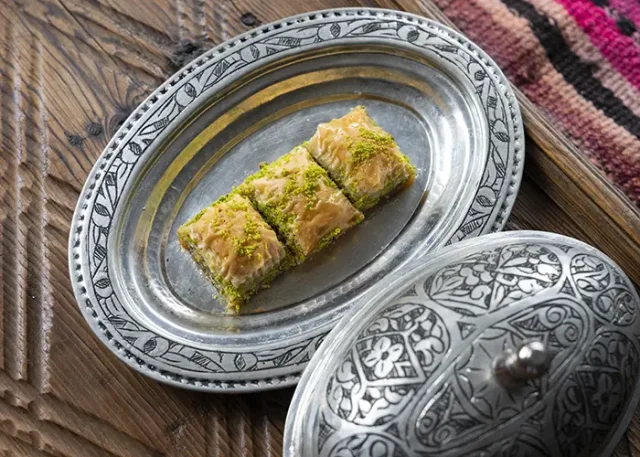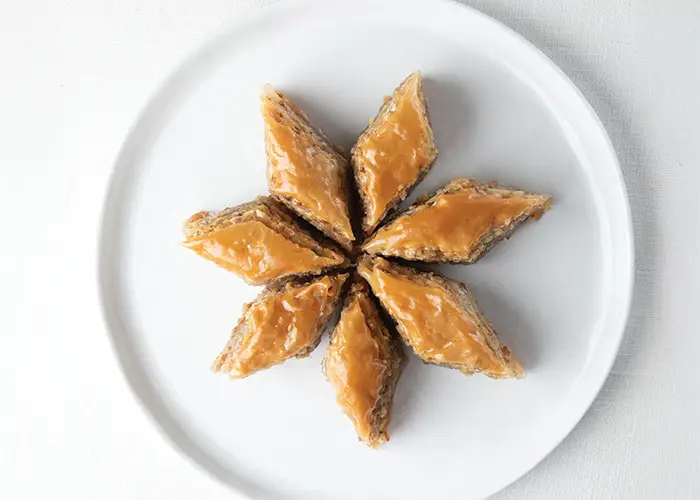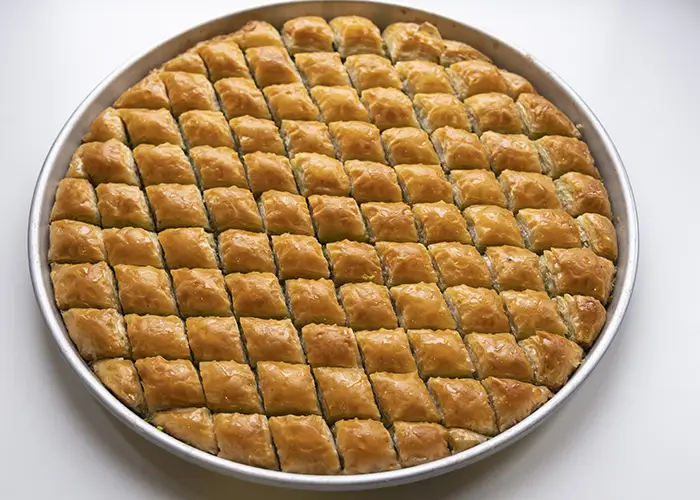
Türkiye’s world-famous dessert, Baklava, is being celebrated globally on November 17 — World Baklava Day. With a golden crust and light syrup, Baklava offers a memorable taste that lingers long after the first bite. Whether you’re a connoisseur or a curious foodie, the best place to savour this flaky delicacy is in Türkiye.
Celebrated among the world’s best desserts, Baklava has travelled far beyond its origins – spreading across continents through Türkiye’s rich exports and the rise of Turkish pastry shops worldwide. From Canada to Japan, baklava boutiques opened by Turkish masters draw long queues of dessert lovers, eager for an authentic taste of the sweet treat.
Traditionally made with 40 layers of phyllo dough, filled with pistachios or walnuts, and sweetened with syrup, baklava captures the essence of indulgence.
Originating from Türkiye’s yufka (phyllo dough) tradition — inscribed on UNESCO’s Representative List of the Intangible Cultural Heritage of Humanity — baklava reached perfection in the Ottoman imperial kitchens, where masters rolled dough as thin as rose petals. Once a symbol of skill and prestige in the palace, it remains a beloved emblem of celebration and hospitality. Whether offered with tea or coffee, or served on special days like weddings and religious holidays, baklava continues to bring people together in moments of joy.
Gaziantep Province: The Baklava Capital
Mastering baklava requires skill, patience, and a deep understanding of ingredients. The finest version is prepared in Türkiye’s southeastern Gaziantep province, a member of the UNESCO Creative Cities Network in the field of gastronomy.
Gaziantep baklava is the first Turkish product to be granted protected status by the European Union (EU). What makes Gaziantep baklava special is not only the expert method used to craft thin layers of dough but also exceptional ingredients, including high-quality Antep pistachios and locally produced butter. Baklava masters in the city stretch dough manually until it becomes almost transparent and then generous amounts of crushed pistachios and butter are added between the delicate layers. It is baked carefully in wood-fired ovens, giving it a signature yellow colour. When all this process is completed, a syrup is poured over the freshly baked baklava, allowing it to soak in slowly. The result is the perfect Gaziantep baklava, which is crispy on the outside, soft inside, and sweet yet never heavy.

Varieties of Baklava
Countless varieties of this beloved dessert are prepared across Türkiye, with unique methods and ingredients. Some are named after their distinctive shapes, such as havuç dilimi baklava (carrot-slice baklava), midye baklava (mussel-shaped baklava), made by shrinking the phyllo, and bülbül yuvası (nightingale’s nest), in which the shrunken phyllo is shaped into a ring. Others are defined by their ingredients, including şöbiyet, prepared with clotted cream (kaymak) between the pastry layers in addition to nuts; sütlü nuriye (milky radiance), prepared with milk instead of syrup; and kuru baklava, made with less syrup for those who prefer a crispier texture. Also, fıstık sarma (pistachio rolls) and ceviz sarma (walnut rolls), feature an abundance of crushed pistachios and walnuts.
A new generation of chefs are also bringing a modern twist to the timeless classic. One of the latest varieties is cold baklava, prepared with less syrup, milk, and chocolate, and it has become one of the most popular dessert orders in Türkiye. Whether in its modern or traditional form, baklava remains an irresistible, timeless delight. Why not creating your own Baklava Route to honour and enjoy this world-famous dessert on World Baklava Day?
Official Baklava Recipe

Serves 10 Walnuts are traditionally preferred as a filling for homemade baklava, while pistachios are generally used in baklavas sold in shops.
Ingredients
Syrup
600 g sugar
500 ml water
10 ml lemon juice
Dough
500 g all-purpose flour
2 eggs
80 ml water
15 ml olive oil
10 ml lemon juice
1⁄4 teaspoon salt
80 g starch
220 g Antep pistachios or walnuts, coarsely crushed
500 g butter or clarified butter
1. Mix sugar and water in a small saucepan to make the syrup. Stir over low heat until the sugar is dissolved, then boil gently for 5 minutes. Add the lemon juice and boil for 1 more minute. Remove from the heat and set aside.
2. Sift the flour into a large mixing bowl. Make a well in the center and break the eggs into it. Add the water, olive oil, lemon juice and salt. Knead well until the dough is quite firm. Roll the dough into a cylinder and divide into 20 equal pieces. Shape into balls and cover with a cotton cloth.
3. Roll out each ball of dough with a thin rolling pin until it is paper thin. Sprinkle each ball with starch while rolling it out to make it thinner.
4. Stack the first 10 sheets of dough sprinkling starch between each sheet and set aside and cover. Then roll out the remaining balls of dough.
5. Place the first 10 sheets of the dough one by one in a 38-40 cm ungreased round baking tray taking care to brush off excess starch. Remove any dough hanging over the tray.
6. Distribute walnuts or pistachios over the dough and arrange the remaining sheets in the tray in the same way. Evenly cut the excess dough. Then with a sharp knife cut the dough to make 4-5 cm diamond shapes. It can also be cut into squares.
7. In a small pan, melt the butter and pour over the baklava. Place in a preheated 400 °F oven and bake for 40-45 minutes until golden.
8. Remove from the oven. Immediately pour the previously prepared, cooled syrup over the hot baklava. Cover and leave to cool before serving.





